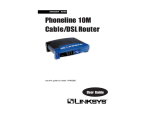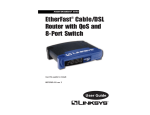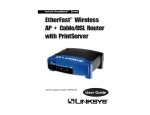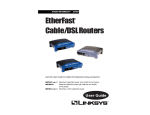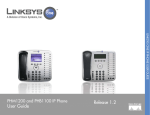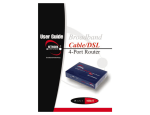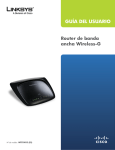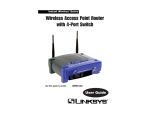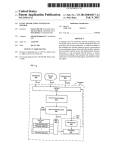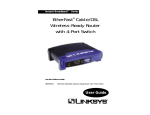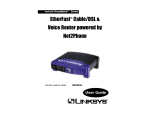Download Linksys EtherFast BEFSR81 User's Manual
Transcript
Instant Broadband™ Series
EtherFast Cable/DSL
Router
Model No.:
BEFSR81
User Guide
COPYRIGHT & TRADEMARKS
Copyright © 2000 Linksys, All Rights Reserved. Instant Broadband is a registered
trademark of Linksys. Microsoft, Windows, and the Windows logo are registered trademarks of Microsoft Corporation. All other trademarks and brand names are the property of their respective proprietors.
LIMITED WARRANTY
Linksys guarantees that every Instant Broadband EtherFast Cable/DSL Router is free
from physical defects in material and workmanship under normal use for one year from
the date of purchase. If the product proves defective during this warranty period, call
Linksys Customer Support in order to obtain a Return Authorization Number. BE SURE
TO HAVE YOUR PROOF OF PURCHASE AND A BARCODE FROM THE PRODUCT'S
PACKAGING ON HAND WHEN CALLING. RETURN REQUESTS CANNOT BE
PROCESSED WITHOUT PROOF OF PURCHASE. When returning a product, mark the
Return Authorization Number clearly on the outside of the package and include your
original proof of purchase.
IN NO EVENT SHALL LINKSYS’ LIABILITY EXCEED THE PRICE PAID FOR THE PRODUCT FROM DIRECT, INDIRECT, SPECIAL, INCIDENTAL, OR CONSEQUENTIAL DAMAGES RESULTING FROM THE USE OF THE PRODUCT, ITS ACCOMPANYING SOFTWARE, OR ITS DOCUMENTATION. LINKSYS DOES NOT OFFER REFUNDS FOR ANY
PRODUCT. Linksys makes no warranty or representation, expressed, implied, or statutory, with respect to its products or the contents or use of this documentation and all
accompanying software, and specifically disclaims its quality, performance, merchantability, or fitness for any particular purpose. Linksys reserves the right to revise or
update its products, software, or documentation without obligation to notify any individual or entity. Please direct all inquiries to:
Linksys P.O. Box 18558, Irvine, CA 92623.
FCC STATEMENT
This Instant Broadband EtherFast Cable/DSL Router has been tested and complies
with the specifications for a Class B digital device, pursuant to Part 15 of the FCC
Rules. These limits are designed to provide reasonable protection against harmful
interference in a residential installation. This equipment generates, uses, and can radiate radio frequency energy and, if not installed and used according to the instructions,
may cause harmful interference to radio communications. However, there is no guarantee that interference will not occur in a particular installation. If this equipment does
cause harmful interference to radio or television reception, which is found by turning
the equipment off and on, the user is encouraged to try to correct the interference by
one or more of the following measures:
•
•
•
•
Reorient or relocate the receiving antenna
Increase the separation between the equipment or device
Connect the equipment to an outlet other than the receiver’s
Consult a dealer or an experienced radio/TV technician for assistance
010
Instant Broadband Series
Table of Contents
Introduction
Introduction
The Linkys EtherFast Cable/DSL Router
Features
Package Contents
System Requirements
1
1
1
2
2
Getting to Know the
8-Port EtherFast Cable/DSL Router
The 8-Port Router’s Rear Panel
The Reset Button
The 8-Port Router’s Front Panel LEDs
3
3
4
4
Connecting The Cable/DSL Router to
Your Network
Overview
About Static & Dynamic IP Addresses
Connecting Everything Together & Booting Up
6
6
6
7
Configuring Your Network with
the Cable/DSL Router
Configuring The Cable/DSL Router
Configuring Your PCs to Connect to the Cable/DSL Router
EtherFast Cable/DSL Router
The Linksys EtherFast Cable/DSL Router
Congratulations on your purchase of a Linksys Instant Broadband EtherFast
Cable/DSL Router. The EtherFast Cable/DSL Router is the perfect option to
connect a small group of PCs to a high-speed Broadband Internet connection
or to an Ethernet backbone. Configurable as a DHCP server, the EtherFast
Cable/DSL Router can act as the only externally recognized Internet gateway on
your local area network (LAN) and, with QoS, you can prioritize performance for
FTP, HTTP, and other services. The Router serves as an Internet firewall, shielding
your network from unwanted access and monitoring and filtering all incoming
data packets. The Router can also be configured to filter internal users' access to
the Internet.
Not only will all of your PCs now be able to enjoy your lightning-fast
Broadband Internet connection, they will also be able to share internal network data. Add it all together and your small network will hum along faster
than you ever thought possible.
Features
9
9
12
The Cable/DSL Router’s Web-based Utility
15
Troubleshooting
30
Appendix
SNMP Functions
How to Ping Your ISP’s E-mail & Web Addresses
Installing the TCP/IP Protocol
Twisted-Pair Cabling
Crimping Your Own Network Cables
8-Port Router Specifications
Customer Support
36
36
36
39
41
42
43
44
• Connects to a Broadband modem or to an Ethernet backbone.
• Equipped with an 8-port 10/100 Switch. Manually select port eight as the
uplink port.
• Connects all of your PCs to the Internet with only one purchased IP address.
• Creates a firewall to protect your PCs from outside intruders.
• Configurable through any networked PC's web browser using Netscape or
Internet Explorer, versions 4.0 or higher.
• The switch dramatically speeds up your gaming and multimedia connections.
• QoS (Quality of Service) allows you to prioritize performance.
• Can simultaneously act as both a DHCP Server on the LAN and a DHCP
Client on the WAN.
• Compatible with virtually all standard Internet applications.
• Administrators can block specific interior users' Internet access.
• DMZ Host option provides two-way communication between one PC and
your Internet services.
1
Instant Broadband Series
EtherFast Cable/DSL Router
Getting to Know the 8-Port
EtherFast Cable/DSL Router
The 8-Port Router’s Rear Panel
The rear panel of the Router is where all of the Router’s connections are
made.
Package Contents
• One Linksys Instant Broadband Cable/DSL Router
• One power adapter
• One power cord
• One user guide and registration card
The 8-Port Router’s Ports
WAN
The WAN (Wide Area Network) Port is where you
will connect your cable or DSL modem.
Ports 1-8
These eight LAN (Local Area Network) ports are
where you will connect networked devices, such as
PCs, print servers, remote hard drives, and anything else you want to put on your network.
Uplink Toggle
The Uplink Toggle allows you to manually select
Port Eight as an Uplink Port so that you can
expand your network by connecting to another
switch or hub. Uplinking to another Router, switch
or hub is done by simply selecting the crossed setting and running a cable from Port Eight to the
device.
Power
The Power Port is where you will connect the
included AC Power adapter.
System Requirements
• One RJ-45 Broadband Internet connection
• One PC with an installed 10Mbps, 100Mbps, or 10/100 Mbps Ethernet card
• TCP/IP network protocol for each PC
• UTP network cable with RJ-45 connector
• Microsoft Internet Explorer 4.0 or later, or Netscape Navigator 4.0 or later.
(5.0 and 4.7, respectively, are strongly recommended.)
2
3
Instant Broadband Series
The Reset Button
EtherFast Cable/DSL Router
Full/Col
Green. The Full/Col LED also serves two purposes. If this
LED is continuously illuminated, the connection made
through the corresponding port is successfully running in
Full Duplex mode. If the LED is flickering, the connection
is experiencing collisions. Infrequent collisions are normal.
If this LED is flickering too often, there may be a problem
with your connection. Check the Troubleshooting section on
page 30 if you think there is a problem.
100
Orange. The 100 LED illuminates when a successful
100Mbps connection is made through the corresponding
port.
Briefly pressing the Reset Button will refresh the Router’s connections, potentially clearing any jammed links.
Pressing the Reset Button and holding it in for a few seconds will
clear all of the Router’s data. This should be done only if you are experiencing heavy routing problems, and only after you have exhausted all of the
other troubleshooting options. By resetting the Router, you run the risk of
creating conflicts between your PCs’ actual IP Addresses and what the Router
thinks their IP Addresses should be. You may be forced to reboot the entire
system(s).
If the Router locks up, simply power it down for 3 to 5 seconds by removing
the power cable from the Router’s Power Port. Leaving the power off for too
long could result in the loss of network connections.
The WAN Indicators
Link
Green. The Link LED illuminates when a successful connection is made between the Router and your Broadband
device or network.
Act
Green. The Act LED flickers when the Router is sending or
receiving data over the broadband port.
Diag
Red. The Diag LED illuminates when the Router goes
through its self-diagnosis mode during boot-up. It will turn
off upon successful completion of the diagnosis. If this
LED stays on for an abnormally long period of time, refer
to Troubleshooting on page 30.
The 8-Port Router’s Front Panel LEDs
The LAN Indicators
4
Power
Green. The Power LED illuminates when the Router is powered on.
Link/Act
Green. The Link/Act LED serves two purposes. If the LED
is continuously illuminated, the Router is successfully connected to a device through the corresponding port (1-8). If
the LED is flickering, the Router is actively sending or
receiving data over that port.
5
Instant Broadband Series
Connecting The Cable/DSL Router
to Your Network
Overview
Dynamic IP Addresses A dynamic IP address is an IP address that is automatically assigned to a client station (computer, printer, etc.) in a TCP/IP network.
Dynamic IP addresses are typically assigned by a DHCP server, which can be
a computer on the network or another piece of hardware, such as the Router.
A dynamic IP address may change every time your computer connects to the
network.
Unlike a simple hub or switch, the setup of the Cable/DSL Router consists of
more than simply plugging everything together. Because the Router acts as a
DHCP server, you will have to set some values within the Router, and also
configure your networked PCs to accept the IP Addresses the Router chooses
to assign them.
DHCP (Dynamic Host Configuration Protocol) DHCP is software that automatically assigns IP addresses to client stations logging onto a TCP/IP network.
DHCP eliminates having to manually assign permanent IP addresses to every
device on your network. DHCP software typically runs in servers and is also
found in network devices such as Routers.
You will need the following values from your ISP in order to install the
Cable/DSL Router:
Connecting Everything Together & Booting Up
• Your broadband-configured PC’s fixed Internet IP Address (if applicable)
• Your broadband-configured PC’s Computer Name and Workgroup Name
• Your Subnet Mask
• Your Default Gateway
Only if applicable
• Your Primary DNS IP address
}
Whoever installed your broadband access should have left this information
with you. If not, call your ISP and they will be able to supply you with it.
About Static & Dynamic IP Addresses
Static IP Addresses A static IP address is an IP address permanently assigned
to a computer in a TCP/IP network. Static IP addresses are usually assigned
to networked devices which are consistently accessed by multiple users, such
as Server PCs, or printers. If you are using the Router to share your cable or
DSL Internet connection, contact your ISP to see if they have assigned your
home a static IP address. You will need that address during the Router’s configuration.
6
EtherFast Cable/DSL Router
Note: Some ISPs—most notably
Once you are sure that you
some cable providers—configure
their networks so that you do not
have the above values on hand,
have to enter a full Internet address
you can begin the Installation
into your web browser or e-mail
and Setup of the Cable/DSL
application to reach your home page or receive
Router.
your e-mail. If your Internet home page address is
1. Power everything down,
including your PCs, your
Cable or DSL modem and
the Router.
something very simple, such as “www”, rather
than “www.linksys.com”, or your e-mail server’s
address is something similar to “e-mail” or “pop3”,
rather than “pop.mail.linksys.com”, you won’t be
able to properly configure the Cable/DSL Router
until you determine the actual Internet addresses
of your Web and e-mail connections.
2. Connect a Network cable You must obtain this information prior to connectfrom one of your PCs’
ing the Router to your network. You can obtain this
Ethernet ports to one of the information by contacting your ISP, or turn to page
35 to learn how to ping for an IP address.
LAN Ports on the back of
the Router. Do the same with all the PCs you wish to connect to the
Router. (LAN Port 8 will become inactive if you toggle the Uplink port.)
3. Connect the network cable from your Cable or DSL modem to the WAN
port on the rear of the Router.
7
Instant Broadband Series
4. Connect the power-supply cable to the Power port on the rear of the
Router, then plug the supplied AC power cable into a power outlet. Plug the
other end into the back of the power adapter.
• The Power LED will illuminate green as soon as the power adapter is
connected.
• The Diag LED will illuminate red for a few seconds while the Router
goes through its internal diagnostic test. The LED will turn off when the
self-test is complete.
5. Power on the Cable or DSL modem.
6. Press the Reset button on the back of the Router. Hold the button in for
three seconds, or until the Diag LED illuminates red. This restores the
router’s default settings.
EtherFast Cable/DSL Router
Configuring Your Network with the
Cable/DSL Router
Configuring the Cable/DSL Router
Now that the Cable/DSL Router is wired into your network, you can begin configuring your system.
Note: If the TCP/IP
protocol is not configured on your PC, go
to page 38 of the
Appendix for TCP/IP
installation instructions now.
1. Open your web browser and type http://192.168.1.1 in the
browser’s Address box. This number is the default IP address of the Router.
Press Enter.
The Hardware Installation is complete.
2. A User Name and password prompt will appear. Leave the User Name
box empty and type admin (the default password) in the Password box.
Click OK.
Note: If you have previously enabled an Internet Sharing Proxy
Service on any of your PCs, you must disable it now.
• If you are running Netscape Navigator: Click Edit >> Preference
>> Advanced >> Proxies> and click Direct Connection to the Internet.
• If you are running Internet Explorer v5 or better, click Start>> Settings>>
Control Panel>> Internet Options>> Connections>> LAN Settings. Remove
the checks from all three boxes. Click OK to continue.
8
9
Instant Broadband Series
3. The Cable/DSL Router’s Setup page will appear.
EtherFast Cable/DSL Router
LAN IP Address These values refer to your
internal network settings. Unless you have
specific internal needs, there should be no
reason to change these values. For the internal LAN, the default values are as follows.
• Private IP Address:
192.168.1.1
• Subnet Mask:
255.255.255.0
Note: If you have an existing
DHCP server on your LAN
and you don’t wish to use
the router as your new
DHCP server, you must
assign your router a static IP
address. The router’s IP
address must be compatible
with your existing network.
You can not have two DHCP
servers running on one LAN
at the same time.
WAN IP Address These values refer to the
outside network you connect to every time
you access your Broadband Internet connection. Most Broadband ISPs assign their clients with a different IP address
each time they log on. If this is the case with your ISP, click Obtain an
IP Address Automatically and continue to step 5. If your ISP assigns
you a fixed IP address, click Specify an IP Address and enter the
address into the Subnet Mask, Default Gateway Address and DNS
fields provided by the ISP.
To enable PPPoE support, choose Enable, and enter your User
Name and Password. If you do enable PPPoE, remember to
remove any existing PPPoE applications already on your computer. (More information on PPPoE can be found on page 17.)
5. When you have properly configured the Setup page, click Apply, then
click Continue.
6. Choose the DHCP tab.
4. Configure the following values.
Note: The setup page
shown in the graphic
above may differ from
the one seen on your
router.
Router Name & Domain Name These fields allow you to supply a host
and domain name for the Router. Some ISPs require these names as
identification. You may have to check with your ISP to see if your
Broadband Internet service has been configured with a host and domain
name. In most cases, leaving these fields blank will work.
10
11
Instant Broadband Series
7. Unless you already have a DHCP server on your internal network,
choose Enable from the DHCP Server field. By choosing Enable, you will
configure the Router to automatically assign IP addresses to each of your
PCs. In the Number of DHCP Users box, enter the number of PCs you plan
on networking to the Router, or leave it alone. Don’t forget to change this
number if, in the future, you add more PCs to your network.
EtherFast Cable/DSL Router
3. In the Configuration window, select the TCP/IP protocol line that has
been associated with your network card/adapter. If there is no TCP/IP line
listed, go to page 39 to install the TCP/IP Protocol now.
8. Click Apply, then click Continue.
9. Reset the power on the cable or DSL modem, then restart the computer
so the computer can obtain the new Router information.
The Cable/DSL Router is now configured to your network. Please continue to the following section to complete your network setup.
Configuring Your PCs to Connect to the Cable/DSL Router
Now that the Router is configured, you will have to
configure your other PCs to accept the IP addresses
that the Router will provide.
Note: Make sure that a
Network Card or
Adapter has been successfully installed into
each PC you plan on
configuring prior to
continuing.
4. Click the Properties button, then choose the IP Address tab. Select
Obtain an IP address automatically. Press OK. You have completed the
client settings.
These instructions apply only to Windows 95 and Windows 98
machines. For TCP/IP setup under Windows NT, please refer to
your Windows NT manual.
1. Click the Start button, select Settings, then Control Panel.
2. Double-click the Network icon.
12
13
Instant Broadband Series
5. Click OK. Windows may ask for original Windows installation files.
Supply them as needed (i.e.: D:\win98, D:\win95,
c:\windows\options\cabs.)
EtherFast Cable/DSL Router
The Cable/DSL Router’s Web-based
Utility
6. Windows will ask you to restart the PC. Click Yes.
Repeat steps 1-6 for each PC on your network. When all of your PCs are
configured, the Cable/DSL Router Setup and Installation is complete.
If you would like, you may continue on to learn more about the Router’s
Web-based Utility.
Quick & Easy Administration
The EtherFast Cable/DSL Router has an internal integrated-circuit chip with
no keyboard, monitor or mouse capabilities. Because of these limitations, an
administrative utility has been programmed into that chip. All router-based
administrative tasks are performed through this utility. The utility can be
accessed by any PC on the network by typing http://192.168.1.1 into
the PC’s web browser address window.
Upon entering the address into the web browser, a password request page will
pop up.
Leave the User Name field empty, but type “admin” into the Password field.
On the following pages you will find brief descriptions of each utility webpage and each page’s more important functions. More detailed explanations
and instructions can be found by clicking each page’s Help button. To apply
any settings you’ve altered on any page, click the Apply button, then click
Continue. To clear any values you’ve entered on any page, click Cancel.
14
15
Instant Broadband Series
Setup
Note: The Setup
page shown in the
graphic below may
differ from the one
seen on your router.
EtherFast Cable/DSL Router
• Default Gateway Address Your ISP will provide you with the Gateway IP
Address. If set to Obtain an IP address automatically, these values are
assigned by your ISP.
• DNS (Domain Name Server) IP Address Your ISP will provide you with
at least one DNS IP Address. If set to Obtain an IP address automatically,
these values are assigned by your ISP.
You can test and see if the above settings are correct by successfully connecting to the Internet.
• PPPoE (Point-to-Point Protocol over Ethernet) Some DSL-based ISPs
use PPPoE to establish communications with an end-user. If you are connected to the Internet through a DSL line, check with your ISP to see if
they use PPPoE. If they do, you will have Enable it. To enable PPPoE:
1. Choose the Enable option within the PPPoE area of the Setup screen.
2. Enter the User Name you use to log onto your Internet connection.
3. Enter your corresponding Password.
• MAC Address Cloning Click on "MAC Address" (next to WAN IP
Address) to display your Router's MAC address, which is a 12-digit code
assigned to a unique piece of hardware for identification, like a social
security number. Some ISPs require that you register the MAC address of
your network card/adapter, which was connected to your cable or DSL
modem during installation. If your ISPs require MAC address registration, find your adapter's MAC address by doing the following:
The Basic Setup screen is the first screen you will see when you access the Utility.
If you have already installed and setup the Router, you have already seen this
screen and have already properly configured all of the screen’s values.
• Router Name This entry is necessary for some ISPs.
• Domain Name This entry is necessary for some ISPs.
• Firmware Version This entry shows the version of the firmware you are
using. Future versions of the Router’s Firmware may become available on the
Linksys Website.
• LAN IP Address and Subnet Mask The IP Address and Subnet Mask of the
Router as it is seen on the internal LAN. The default value is 192.168.1.1 for
IP and 255.255.255.0 for Subnet Mask.
• WAN IP Address and Subnet Mask The IP Address and Subnet Mask of the
Router as seen by external users on the Internet (including your ISP). If set to
Obtain an IP address automatically, these values are assigned by your ISP.
16
Enter those 12 digits into the fields below, and click Apply. This “clones”
your network adapter’s MAC address onto your Router, and prevents you
from having to call your ISP to change the registered MAC address to the
Router’s MAC address.
Note: This is a
sample screen.
Please enter
the MAC
Address for
your Network
Card/Adapter
into this field.
17
Instant Broadband Series
Password
EtherFast Cable/DSL Router
Status
It is strongly recommended that you set a password for the Router. When you
first power up the Router, you will notice that the Password setting has been
left blank. When the password field is blank, all users on your network can
access the Router simply by entering the unit's IP address into their web
browser's location window.
If you set the Restore Factory Default option and click Apply, you
will clear all of the Router’s settings. Do not restore to the factory
defaults unless you are having difficulties with the Router. Once
the Router is reset, you will have to re-enter your configuration
information.
18
This screen provides the current status of the device. All of the information
provided is read-only.
• Router Name This field shows the name of this device. This entry is
necessary for some ISPs.
• Firmware Version This field shows the installed version of the firmware.
• PPPoE (Point-to-Point Protocol over Ethernet) This field shows
whether or not you have enabled the use of the Router’s PPPoE support.
Click the Connect button if your PPPoE status is Disconnected. This will
initiate a connection to your ISP. Click Disconnect if you want to cut your
connection to your ISP.
• LAN These fields display the current IP Address and Subnet Mask of the
Router, as seen by users on your internal network.
• DHCP server This field shows the status of the Router's DHCP server
function. This option is either enabled or disabled.
19
Instant Broadband Series
• WAN These fields display the IP Address, Subnet Mask and Gateway IP
of the Router as seen by external users on the Internet.
• DNS (Domain Name Server) IP Address This field shows the IP
Address of the DNS currently being used. Multiple DNS IP settings are
common. The first available DNS entry is used in most cases.
EtherFast Cable/DSL Router
Help
DHCP
Here you will find links to all of the Utility’s internal support documentation,
as well as the application that upgrades the Router’s firmware. To upgrade the
Router’s firmware:
1. Downloaded the latest firmware version from the Linksys website
(www.linksys.com).
2. Go to the Help screen (above).
3. Click Upgrade Firmware. A new page will appear (below).
A DHCP (Dynamic Host Configuration Protocol) Server automatically
assigns IP addresses to each computer on your network. Unless you already
have one, it is highly recommended that the Router be set up as a DHCP
server.
• DHCP Server Check the Enable option to enable the DHCP server
option of the Router. If you already have a DHCP server on your network,
set the Router's DHCP option to Disable.
• Starting IP Address Enter a numerical value for the DHCP server to
start with when issuing IP addresses.
• Number of DHCP users Enter the maximum number of PCs that you
want the DHCP server to assign IP addresses to, with the absolute maximum being 253.
• DHCP Client Table Click on the Client Table button to show the current
DHCP Client information. (This information is stored in temporary memory, so the list of clients could disappear.)
20
4. Enter your Router’s administration password into the Password Confirm
box.
5. Click the Browse button and find the firmware upgrade file that you
downloaded from the Linksys website. Double-click the upgrade file.
6. Click the Upgrade button and follow the instructions there.
21
Instant Broadband Series
Filters
EtherFast Cable/DSL Router
Forwarding
Filters block specific internal users from accessing the Internet. You can set
up a filter through an IP address or a network Port number.
To Modify Filter Settings
• Enter the IP addresses you wish to filter into the IP address fields. The
users who have these IP addresses will not be able to access the Internet.
• You can also filter users by entering their network port number. Enter the
port numbers you want to filter into the port numbers fields. Users who are
connected to the Router will no longer be able to access any port number
listed there.
Block WAN Request
• By enabling the Block WAN Request feature, you can prevent your network
from being pinged, or detected, by other Internet users. The Block WAN
Request feature also adds another measure of security to your network by
hiding your network ports. Both functions of the Block WAN Request feature
make it more difficult for outside users to work their way into your network.
Port forwarding sets up public services on your network. When users from the
Internet make certain requests of your network, the Router will forward those
requests to the appropriate computer. It is recommended that the Router's
DHCP function is disabled when Forwarding.
Forwarding is generally used to set up a webserver, ftp server, or e-mail server on your network. To add a server using Forwarding:
1. Enter the port number used by the server. On the same line, enter the IP
Address of the server that you want the Internet users to be able to access.
2. Configure as many entries as you would like until all of the link entries
are filled.
3. Click the Apply button to save the settings.
Click the Apply button to save any changes.
22
23
Instant Broadband Series
EtherFast Cable/DSL Router
Dynamic Routing
Static Routing
With Dynamic Routing you can automatically adjust to physical changes in
the network's layout. The Router, using the RIP protocol, determines the network packets’ route based on the fewest number of hops between the source
and the destination. The RIP protocol regularly broadcasts routing information to other routers on the network. To set up Dynamic Routing:
If the Router is connected to more than one network, it may be necessary to
set up a static route between them. A static route is a pre-determined pathway
that network information must travel to reach a specific host or network.
Click the Show Routing Table button to view the current static routing configuration.
1. Choose the correct working mode. Gateway Mode should be used if the
Router is hosting your network's connection to the Internet. Router Mode
should be selected if the Router exists on a network with other routers.
To create a static route entry:
1. Select Static Route Entry from the drop down list. The Cable/DSL
Router supports up to 20 static route entries.
2. Choose the protocol by which you transmit data on the network.
3. Choose the protocol by which the Router receives network data.
4. Click the Apply button to save your changes.
24
25
Instant Broadband Series
2. Enter the following data to create a new static route:
EtherFast Cable/DSL Router
DMZ Host
Destination LAN IP The Destination LAN IP is the Address of the remote
network or host to which you want to assign a static route. Enter the IP
address of the host for which you wish to create a static route here. If you
are building a route to an entire network, be sure that the network portion
of the IP address is set to zero. For example, the Router’s standard IP
address is 192.168.1.1. Based on this address, the address of the network
to which the Router is connected is 192.168.1, with the last digit (1, in
this case) determining the Router’s place on the network. Therefore you
would enter the IP address 192.168.1.0 if you wanted to route to the
Router’s entire network, rather than just to the Router.
Network Mask The Network Mask (also known as the Subnet Mask)
determines which portion of an IP address is the network portion, and
which portion is the host portion. In the example above, the Network
Mask is 255.255.255.0. This determines (by using the values 255) that the
first three numbers of an network IP address identify this particular network, while the last digit (from 1 to 254) would identify the specific host.
Gateway IP This IP address should be the IP address of the gateway
device that allows for contact between the Router and the remote network
or host.
3. Click the Apply button to save your changes.
The DMZ Host setting allows one local user to be exposed to the Internet to
use a special-purpose service such as Internet gaming or Video-conferencing.
To expose one computer, enter the computer’s IP address and click the Apply
button. Inactivate DMZ by entering a zero.
26
27
Instant Broadband Series
Quality of Service
EtherFast Cable/DSL Routers
You can also prioritize up to four ports with the Port-based QoS. Port-based
QoS (Quality of Service) settings allow you to prioritize performance on four
of the routers ports. The Routers other four ports are automatically assigned
Low Priority. Port-Based QoS does not require support from your ISP as the
ports prioritized are LAN ports going out to your network.
Qos is Quality of Service, based on the idea that transmission rates, error
rates, and other characteristics can be measured and improved in advance.
Qos is of particular concern for the continuous transmission of high-bandwidth video and multimedia information, which is less dependable under normal, best effort protocols
To use QoS, select Enable. There are two types of Qos which can manage
the quality of service: Application-based and Port-based.
Application-based QoS manages information as it is transmitted and received
and assigns it a high or low priority based upon the selections made on the
QoS screen. There are five preset applications which utilize Applicationbased QoS: FTP, HTTP, Telnet, SMTP, and POP3. You can choose three additional applications by inputing that information in the empty boxes below.
28
29
Instant Broadband Series
Troubleshooting
Common Problems and Solutions
This section provides possible solutions to problems regarding the installation
and operation of the Cable/DSL Router. Read the description below to solve
your problems. If you can’t find an answer here, check the Linksys website at
www.linksys.com.
1. I Can’t connect to the Cable/DSL Router.
• Verify that the Cable/DSL Router is properly installed, LAN connections are OK, and it is powered ON.
• Make sure that your PC and the Cable/DSL Router are on the same network segment. If you are not sure, initiate the DHCP function and let
the PC get the IP address automatically.
• Make sure that your PC is using an IP address within the default range
of 192.168.1.2 to 192.168.1.254 and thus compatible with the
Cable/DSL Router default IP Address of 192.168.1.1.
• The Subnet Mask should be set to 255.255.255.0 to match the
Cable/DSL Router. In the Cable/DSL Router, you can check these settings by using Control Panel-Network to check the Properties for the
TCP/IP protocol.
2. The Diag LED stays lit when it shouldn’t.
• The Diag LED lights up when the device is first powered up.
Meantime, the system will boot up itself and check for proper operation. After finishing the checking procedure, the LED turns off to show
the system is working fine. If the LED remains lit after this time, the
device is not working properly. Try to re-flash the firmware by assigning a static IP address to the computer, then upgrade the firmware
again. If that doesn’t help, contact your dealer for further information.
30
EtherFast Cable/DSL Routers
3. I can’t browse through the Cable/DSL Router.
• Make sure that both ends of the network cable and power adapter are
properly connected and that the status LEDs on the front panel are
functioning properly.
• If using Windows 95 or Windows 98, check the TCP/IP setup on the
client side. Run "winipcfg" by clicking on the Start button, then selecting Run. The PC should have an IP address of 192.168.1.xxx ("xxx" is
from 2 to 254.) Subnet Mask is 255.255.255.0, the default gateway IP
should be the Router’s IP Address, and DNS (in "More".)
• Make sure that the same values are in the Status screen of the
Cable/DSL Router’s web-based utility.
4. When I enter a URL or IP address, I get a time out error.
• Make sure that the other PCs work. If they do, ensure that your workstations IP settings are correct (IP address, Subnet Mask, Default gateway and DNS)
• If the PCs are configured correctly, but still not working, check the
Cable/DSL Router to make sure that it is connected and ON. Once this
is the case, check its settings. (If you cannot connect to the Router,
check the LAN and power connections.)
• If the Cable/DSL Router is configured correctly, check your Internet
connection (the Cable/DSL modem) to see that it is working correctly.
5. I can’t obtain an IP address from my cable or DSL modem.
• Make sure that all of your cabling is properly connected and that all of
the Router’s WAN and LAN LEDs are correctly illuminated.
• Power down your cable or DSL modem for a few seconds. Turn it back
on. After the modem goes through its self-test, check to see that you
now have an IP address.
• Make sure that your cable or DSL modem is DHCP-capable.
• You may have to enter the Router or host name in the Setup page of the
Router’s web-based utility. Go to page 16 for more information.
• Your ISP may require Mac Addresses. Check with your ISP. This
address can be obtained in the Status screen of the Router’s Web-based
Utility.
31
Instant Broadband Series
Frequently Asked Questions
What is MIB? MIB (Management Information Base) is a data file that works in
tangent with third-party SNMP software in managing your Router. To use
MIB files in tangent with third-party SNMP software, follow the instructions that come with the thirty-party SNMP software. MIB data files will be
available on the Linksys web site: www.linksys.com.
Can I use firmware for other routers with my BEFSR81? No. If you attempt to
use other router's firmware, you could damage your router. Only use
firmware specifically written for the BEFSR81 as posted on the Linksys
web site: www.linksys.com.
What is Qos? “Qos” is Quality of Service, based on the idea that transmission
rates, error rates, and other characteristics can be measured and improved in
advance. For more infomation on Qos, see the QoS section on page 28.
What is SNMP? SNMP (Simple Network Management Protocol) is a widelyused network monitoring and control protocol. For more information on
SNMP, see the SNMP section in the Appendix.
What is the maximum number of IP addresses and users supported by the
Cable/DSL Router? The Router supports up to 253 IP addresses and users.
Where is the Cable/DSL Router installed on the network? In a typical environment, the Router is installed between the Cable/DSL Modem and the LAN.
Plug the Cable/DSL Router into the Cable/DSL Modem's Ethernet port.
Does the Cable/DSL Router support IPX or AppleTalk? No. TCP/IP is the only
protocol standard for the Internet and has become the global standard for
communications. IPX, a NetWare communications protocol used only to
route messages from one node to another, and AppleTalk, a communications
protocol used on Apple and Macintosh networks, can be used from LAN to
LAN connections, but those protocols cannot connect from WAN to LAN.
Does the WAN connection of the Cable/DSL Router support 100Mb Ethernet?
Because of the speed limitations of broadband Internet connections, the
Cable/DSL Router’s current hardware design supports 10Mb Ethernet on its
WAN port. It does, of course, support 100Mbps over in the auto-sensing
Fast Ethernet 10/100 switch on the LAN side of the Router.
32
EtherFast Cable/DSL Routers
What is Network Address Translation and what is it used for? Network
Address Translation (NAT) translates multiple IP addresses on the private
LAN to one public address that is sent out to the Internet. This adds a level
of security since the address of a PC connected to the private LAN is never
transmitted on the Internet. Furthermore, NAT allows the Cable/DSL Router
to be used with low cost Internet accounts, such as cable or DSL modems,
where only one TCP/IP address is provided by the ISP. The user may have
many private addresses behind this single address provided by the ISP.
Does the Cable/DSL Router support any operating system other than Windows
95, Windows 98, Windows 2000, or Windows NT? Yes, but Linksys does not, at
this time, provide technical support for setup, configuration or troubleshooting of any non-Windows operating systems.
Does the Cable/DSL Router support ICQ send file? Yes, with the following fix:
ICQ menu-> preference -> connections tab-> check "I am behind a firewall
or proxy", and set the firewall time-out to 80 seconds in firewall setting.
The Internet user can then send a file to a user behind the Router.
I setup an Unreal Tournament Server, but others on the LAN cannot join. What do
I need to do? If you have a dedicated Unreal Tournament server running,
you need to create a static IP for each of the LAN computers and forward
ports 7777, 7778, 7779, 7780, 7781, and 27900 to the IP address of the
server. If you want to use the UT Server Admin, forward another port (8080
usually works well), then in the [UWeb.WebServer] section of the server.ini
file, set the ListenPort to 8080 (to match the mapped port above) and
ServerName to the IP assigned to the Router from your ISP.
How do I get Half-Life: Team Fortress to Work with the Router? The default
client port for Half-Life is 27005. The computers on your LAN need to
have "+clientport 2700x" to the HL shortcut command line; the x would be
6, 7, 8, and on up. This lets multiple computers connect to the same server.
One problem: version 1.0.1.6 won't let multiple computers with the same
CD key connect at the same time, even if on the same LAN (not a problem
with 1.0.1.3). As far as hosting games, the HL server does not need to be in
the DMZ. Just forward port 27015 or 27016 to the local IP of the server
computer. There remains, however, a problem with people being booted
after a few minutes with an "illegible server message."
33
Instant Broadband Series
EtherFast Cable/DSL Routers
Can multiple gamers on the LAN get on one game server and play simultaneously with just one public IP address? It depends on the which network game or
what kind of game server you are using. For example, Unreal Tournament
supports multi-login with one public IP.
What is DMZ? Demilitarized Zone (DMZ) allows one IP Address (computer)
to be exposed to the Internet. Some applications require multiple TCP/IP
ports to be open. It is recommended that you set your computer with a static IP if you want to use DMZ.
How can I not receive corrupted FTP downloads? If you are experiencing corrupted files when you download a file with your FTP client, try using
another FTP program.
If DMZ is used, does the exposed user share the public IP with the Router? No.
Does the Router pass PPTP packets or actively route PPTP sessions? The
Router allows PPTP packets to pass through.
Web page hangs, corrupt downloads, or nothing but junk characters are being
displayed on the screen. What do I need to do? Force your NIC to 10Mbps
or half duplex mode, and turn off the "Auto-negotiate" feature of your NIC
as a temporary measure. (Please look at the Network Control Panel, in your
Ethernet Adapter's Advanced Properties tab.). Check our website at
www.linksys.com for more information.
Is the Router cross-platform compatible? Any platform that supports Ethernet
and TCP/IP is compatible with the Router.
If all else fails in the installation, what can I do? Reset the Router by holding
down the reset button for at least three seconds and reset your cable or DSL
modem by powering the unit off and then on. Obtain and flash the latest
firmware release that is readily available on Linksys website,
www.linksys.com.
Does the Router replace a modem? Is there a cable or DSL modem in the
Router? No, this version of the Router must work in conjunction with a
cable or DSL modem.
How can I find upgrades to the Router’s firmware? All Linksys firmware
upgrades are posted on the Linksys website at www.linksys.com, where
they can downloaded for free. The Router's firmware can be upgraded with
TFTP programs.
Will the Router function in a Macintosh environment? Yes, but the Router's
setup pages are accessible only through Internet Explorer or Netscape
Navigator, versions 4.0 or higher for Macintosh.
With which type of firewall is the Router equipped? The Cable/DSL Router
uses NAT and TCP/IP port inspections.
Does the Router do stateful packet inspection? No
Will the Router allow me to use my own public IPs and Domain, or do I have to
use the IPs provided by the Router? The router mode allows for customization of your public IPs and Domain.
Which modems are compatible with the Router? The Router is compatible with
virtually any cable or DSL modem that supports Ethernet.
What are the advanced features of the Router? The Router's advanced features
include Filters, Forwarding, Dynamic Routing, Static Routing, DMZ host
and QoS.
Does Linksys provided syslog support? No, Linksys does not currently provide
syslog support.
How can I check whether I have static or DHCP IP Addresses? Consult your ISP
to confirm the information.
How do I get mIRC to work with the Router? Set port forwarding to 113 for the
computer on which you are using mIRC.
I am not able to get the web configuration screen for the Router. What can I do?
You may have to remove the proxy settings on your Internet browser, e.g.,
Netscape Navigator or Internet Explorer. Or remove the dial-up settings on
your browser. Check with your browser documentation.
34
35
Instant Broadband Series
EtherFast Cable/DSL Router
Appendix
Step One: Pinging for an IP Address
SNMP Functions
The first step to determining your ISP’s web and e-mail server address is to
ping its IP Address.
SNMP (Simple Network Management Protocol) is a widely-used network
monitoring and control protocol. Data is passed from a SNMP agent, such as
the EtherFast Cable/DSL Router to the workstation console used to oversee
the network. The Router then returns information contained in a MIB
(Management Information Base), which is a data structure that defines what
is obtainable from the device and what can be controlled (turned off, on, etc.).
1. Power on the computer and the cable or DSL modem, and restore the
network configuration set by your ISP if you have since changed it.
2. Click Start, then Run, and type "command". This will bring up the DOS
Window.
SNMP functions, such as statistics, configuration, and device information, are
not available without third-party Management Software. The EtherFast
Cable/DSL Router is compatible with all HP Openview compliant software.
3. At the DOS command prompt, type "ping mail" (assuming that the
location for which you’re trying to find an IP address is configured as
“mail”). Press Enter. Information such as the following data, taken from
a ping of Microsoft Network’s e-mail server, will be displayed.
How to Ping Your ISP’s E-mail & Web Addresses
C:\>ping mail
Virtually all Internet addresses are configured with words or characters (i.e.,
www.linksys.com, www.yahoo.com, etc.) In actuality, however, these Internet
addresses are assigned to IP addresses, which are the true addresses on the
Internet. For example, www.linksys.com is actually 206.135.116.3. Type it
into your web browser and you will wind up at the Linksys home page every
time.
Pinging mail [24.53.32.4] with 32 bytes of data:
IP and web addresses, however, can sometimes be long and hard to remember. Because of this, certain ISPs will shorten their server addresses to single
words or codes on their users’ web browser or e-mail configurations. If your
ISP’s E-mail and Web server addresses are configured with single words
(“www”, “e-mail”, “home”, “pop3”, etc.) rather than whole Internet
Addresses or IP Addresses, the Router may have problems sending or receiving mail and accessing the Internet. This happens because the Router has not
been configured by your ISP to accept their abbreviated server addresses.
Ping statistics for 24.53.32.4:
Packets: Sent = 4, Received = 4, Lost = 0 (0%
loss),
Approximate round trip times in milli-seconds:
Minimum = 0ms, Maximum = 0ms, Average = 0ms
Reply
Reply
Reply
Reply
from
from
from
from
24.53.32.4:
24.53.32.4:
24.53.32.4:
24.53.32.4:
bytes=32
bytes=32
bytes=32
bytes=32
time<10ms
time<10ms
time<10ms
time<10ms
TTL=128
TTL=128
TTL=128
TTL=128
4. Write down the IP address returned by the ping command. (In the
example above: 24.53.32.4.) This IP address is the actual IP address of the
server “mail”, or any other word or value you have pinged.
The solution is to determine the true web addresses behind your ISPs code
words. You can determine the IP and web addresses of your ISP’s servers by
“pinging” them.
If you don’t have your ISP’s web and e-mail IP Addresses, you
must either get them from your ISP or follow these steps prior
to connecting the Cable/DSL Router to your network.
36
37
Instant Broadband Series
EtherFast Cable/DSL Router
Step Two: Pinging for a Web Address
Installing the TCP/IP Protocol
While the IP address returned above would work as your e-mail server
address, it may not be permanent. IP Addresses change all the time. Web
addresses, however, usually don’t. Because of this, you’re likely to have less
problems by configuring your system with web addresses rather than IP
addresses. Follow the instructions below to find the web address assigned to
the IP address you just pinged.
Follow these instructions to install the TCP/IP Protocol on one of your PCs
only after a network card has been successfully installed inside the PC. These
instructions are for Windows 95 and Windows 98. For TCP/IP setup under
Windows NT, please refer to your Windows NT manual.
1. At the DOS command prompt, type “ping -a 24.53.32.4”, where
24.53.32.4 is the IP address you just pinged. Information such as the following data will be displayed.
1. Click the Start button. Choose Settings, then Control Panel.
2. Double-click the Network icon. Your Network window should pop up.
Select the Configuration tab.
C:\>ping -a 24.53.32.4
Pinging mail.msnv3.occa.home.com [24.53.32.4] with
32 bytes of data:
Reply
Reply
Reply
Reply
from
from
from
from
24.53.32.4:
24.53.32.4:
24.53.32.4:
24.53.32.4:
bytes=32
bytes=32
bytes=32
bytes=32
time<10ms
time<10ms
time<10ms
time<10ms
TTL=127
TTL=127
TTL=127
TTL=127
Ping statistics for 24.53.32.4:
Packets: Sent = 4, Received = 4, Lost = 0 (0%
loss),
Approximate round trip times in milli-seconds:
Minimum = 0ms, Maximum = 0ms, Average = 0ms
2. Write down the web address returned by the ping command. (In the
example above: mail.msnv3.occa.home.com.) This web address is the web
address assigned to the IP address you just pinged. While the IP address
of “mail” could conceivably change, it is likely that this web address will
not.
3. Click the Add button.
4. Double-click Protocol.
5. Highlight Microsoft under the list of manufactures.
6. Find and double-click TCP/IP in the list to the right (below).
3. Replace your ISP’s abbreviated server address with this extended web
address in the corresponding Internet application (web browser, e-mail
application, etc.).
Once you have replaced the brief server address with the true server address,
the Router should have no problem accessing the Internet through that
Internet application.
38
39
Instant Broadband Series
7. After a few seconds you will be brought back to the main Network window. The TCP/IP Protocol should now be listed.
8. Click OK. Windows may ask for original Windows installation files.
Supply them as needed (i.e.: D:\win98, D:\win95,
c:\windows\options\cabs.)
9. Windows will ask you to restart the PC. Click Yes.
The TCP/IP Installation is complete.
EtherFast Cable/DSL Router
Twisted-Pair Cabling
There are different grades, or categories, of twisted-pair cabling. Category 5
is the most reliable and is highly recommended. Category 3 is a good second
choice. Straight-through cables are used for connecting computers to a hub.
Crossover cables are used for connecting a hub to another hub (there is an
exception: some hubs have a built-in uplink port that is crossed internally,
which allows you to link or connect hubs together with a straight-through
cable instead).
You can buy pre-made Category 5
cabling, or cut and crimp your own.
Category 5 cables can be purchased or
crimped as either straight-through or
crossover. Inside a Category 5 cable are
8 thin, color-coded wires inside that run
from one end of the cable to the other.
All 8 wires are used. In a straightthrough cable, wires 1, 2, 3, and 6 at
one end of the cable are also wires 1, 2,
3, and 6 at the other end. In a crossover
cable, the order of the wires change
from one end to the other: wire 1
becomes 3, and 2 becomes 6. See the
diagrams on the next page for more
detailed information on
straight-through and
crossover cabling.
To determine which wire is wire number 1, hold the cable so that the end of
the plastic RJ-45 tip (the part that goes into a wall jack first) is facing away
from you. Face the clip down so that the copper side faces up (the springy
clip will now be parallel to the floor).When looking down on the copper side,
wire 1 will be on the far left.
40
41
Instant Broadband Series
Crimping Your Own Network Cables
• Straight-Through Cabling
EtherFast Cable/DSL Routers
8-Port Router Specifications
Model Number
Standards
Protocol
Ports
Speed
Cabling Type
Topology
LED Indicators
BEFSR81
IEEE 802.3 10BaseT, 802.3u 100BaseTX
CSMA/CD
Eight 10/100 RJ45 Switched connectors (LAN)
One 10Base-T Ethernet RJ-45 connector for
ADSL/Cable Modem (WAN)
Router - 10Mbps, Switch - 10/100Mbps
10BaseT: UTP/STP Category 3 or 5
100BaseTX: UTP/STP Category 5
Star
Power. Link/Activity, Full Duplex/Collision, Speed
for LAN. Link, Activity, Diag for WAN
Environmental
•Cross-Over Cabling
42
Dimensions
Unit Weight
Power Input
Certifications
Operating Temperature
Storage Temperature
Operating Humidity
Storage Humidity
142 x 236 x 46 mm (5.6 x 9.3 X 1.8 inches)
17.6 oz.
External, 5VDC 3A
FCC Class B, CE Mark Commercial
0°C to 40°C (32°F to 104°F)
-20°C to 70°C (-4°F to 158°F)
10% to 85% non-condensing
5% to 90% non-condensing
43
Instant Broadband Series
EtherFast Cable/DSL Routers
Customer Support
For help with the installation or operation of the Instant Broadband EtherFast
Cable/DSL Router, contact Linksys Customer Support at one of the phone
numbers or Internet addresses below.
Information
Customer Support
Fax
Email
Web
FTP Site
800-546-5797 (LINKSYS)
800-326-7114
949-261-1288
949-261-8868
[email protected]
http://www.linksys.com
ftp.linksys.com
BE SURE TO HAVE YOUR PROOF OF PURCHASE AND A BARCODE
FROM THE PRODUCT'S PACKAGING ON HAND WHEN CALLING.
RETURN REQUESTS CANNOT BE PROCESSED WITHOUT PROOF OF
PURCHASE.
IN NO EVENT SHALL LINKSYS’ LIABILITY EXCEED THE PRICE
PAID FOR THE PRODUCT FROM DIRECT, INDIRECT, SPECIAL, INCIDENTAL, OR CONSEQUENTIAL DAMAGES RESULTING FROM THE
USE OF THE PRODUCT, ITS ACCOMPANYING SOFTWARE, OR ITS
DOCUMENTATION. LINKSYS DOES NOT OFFER REFUNDS FOR ANY
PRODUCT.
44
45
http://www.linksys.com
© Copyright 2000 Linksys, All Rights Reserved.


























